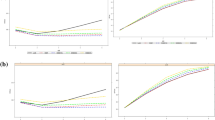Abstract
With reference to a baseline parametrization, we explore highly efficient, fractional factorial designs for inference on the main effects and, perhaps, some interactions. Our tools include approximate theory together with certain, carefully devised discretization procedures. The robustness of these designs to possible model misspecification is investigated using a minimaxity approach. Examples are given to demonstrate that our technique works well even when the run size is quite small.
Similar content being viewed by others
References
Banerjee, T., Mukerjee, R. (2008). Optimal factorial designs for cDNA microarray experiments. The Annals of Applied Statistics, 2, 366–385.
Gupta, S., Mukerjee, R. (1989). A Calculus for Factorial Arrangements. Berlin: Springer.
Kerr, K.F. (2006). Efficient 2\(^{k }\)factorial designs for blocks of size 2 with microarray applications. Journal of Quality Technology, 38, 309–318.
Kerr, K.F. (2012). Optimality criteria for the design of 2-color microarray studies. Statistical Applications in Genetics and Molecular Biology, 11(1) (Article 10).
Li, P., Miller, A., Tang, B. (2014). Algorithmic search for baseline minimum aberration designs. Journal of Statistical Planning and Inference, 149, 172–182.
Lin, D.K.J., Zhou, J. (2013). \(D\)-optimal minimax fractional factorial designs. Canadian Journal of Statistics, 41, 325–340.
Mukerjee, R., Tang, B. (2012). Optimal fractions of two-level factorials under a baseline parametrization. Biometrika, 99, 71–84.
Mukerjee, R., Wu, C. F. J. (2006). A Modern Theory of Factorial Designs. New York: Springer.
Silvey, S. D. (1980). Optimal Design. London: Chapman and Hall.
Wilmut, M., Zhou, J. (2011). \(D\)-optimal minimax design criterion for two-level fractional factorial designs. Journal of Statistical Planning and Inference, 141, 576–587.
Wu, C. F. J., Hamada, M. S. (2009). Experiments: Planning, Analysis and Optimization (2nd ed.). Hoboken, New Jersey: Wiley.
Xu, H., Phoa, F.K.H., Wong, W.K. (2009). Recent developments in nonregular fractional factorial designs. Statistics Surveys, 3, 18–46.
Yang, Y.H., Speed, T. (2002). Design issues for cDNA microarray experiments. Nature Genetics (Supplement), 3, 579–588.
Yin, Y., Zhou. J. (2015). Minimax design criterion for fractional factorial designs. Annals of the Institute of Statistical Mathematics. doi:10.1007/s10463-014-0470-0.
Zhang, R., Mukerjee, R. (2013). Highly efficient factorial designs for cDNA microarray experiments: use of approximate theory together with a step-up step-down procedure. Statistical Applications in Genetics and Molecular Biology, 12, 489–503.
Acknowledgments
We thank the referees for very constructive suggestions. The work of RM was supported by the J. C. Bose National Fellowship of Government of India and a grant from the Indian Institute of Management, Calcutta. The work of SH was supported by a grant from Kuwait University.
Author information
Authors and Affiliations
Corresponding author
Appendix
Appendix
Proof of Lemma 1
By (10), the lemma is obvious if either \(M(p)\) or \(M(\tilde{p})\) is singular. Suppose they are both nonsingular. Then by (5) and (11), on simplification,
i.e., \(M((1-\varepsilon )p+\varepsilon \tilde{p})-\{(1-\varepsilon )M(p)+\varepsilon M(\tilde{p})\}\) is nnd. Since \(M(p)\) and \(M(\tilde{p})\) are both nonsingular, the result now follows from (10). \(\square \)
Proof of Lemma 2
We proceed along the lines of Silvey (1980, pp. 18–20), with more elaborate arguments to cope with the nonlinearity of \(M(p)\) in the elements of \(p\). Let \(\tilde{p}=(\tilde{p}_1 ,\ldots ,\tilde{p}_v )^\mathrm{T}\) and \(p\) be any design measures such that \(M(p)\) is nonsingular. The lemma will follow arguing as in Silvey (1980) if we can show that
and
where \(e_k =z_k -Z^\mathrm{T}p, \,1\le k\le v\). The truth of (27) is not hard to see from Lemma 1. It remains to prove (28). To that effect, observe that by (26), \(M((1-\varepsilon )p+\varepsilon \tilde{p})=(1-\varepsilon )M(p)+\varepsilon Q(\varepsilon )\), where
is nnd, for \(0<\varepsilon <1\). Write \(g=Z^\mathrm{T}(\tilde{p}-p)\) and note that by (5) and (11),
Therefore, \(Q(\varepsilon )=U(\varepsilon )U(\varepsilon )^\mathrm{T}\), where \(U(\varepsilon )\) consists of the \(v+1\) columns \(\tilde{p}_k^{1/2} (e_k -g)\), \(1\le k\le v\), and \((1-\varepsilon )^{1/2}g\). Thus for \(0<\varepsilon <1\), the inverse of \(M((1-\varepsilon )p+\varepsilon {}\tilde{p})\) is given by
where \(\eta =\varepsilon /(1-\varepsilon )\). Hence by (10), after some simplification, the left-hand side of (28) equals
where \(U_0 =\lim _{\varepsilon \rightarrow 0+} U(\varepsilon )\). Since \(\Sigma _{k=1}^v \tilde{p}_k e_k =g\) and, as a consequence, \(U_0 U_0^\mathrm{T} =\Sigma _{k=1}^v \tilde{p}_k e_k e_k^\mathrm{T} \), the truth of (28) is now evident. \(\square \)
Proof of Lemma 3
-
(a)
Note the followings facts: (i) As in (9), \(Z_d^\mathrm{T} L_N P_d =Z^\mathrm{T}\Delta (r_d )P\). (ii) If \(X_d = \quad [1_N \;Z_d ]\), then \(L_N X_d =[0_N \;\;L_N Z_d ]\), so that as in (9), \(Z^\mathrm{T}\Delta (r_d )X=Z_d^\mathrm{T} L_N X_d = \quad [0_q \;\;H_d ]\), using (7); therefore, \(H_d^{-1} Z^\mathrm{T}\Delta (r_d )X=[0_q \;\;I_q ]\). (iii) By the definition of \(P\), the matrix \(PP^\mathrm{T}\) is the orthogonal projector on \(C^{\bot }(X)\), i.e., \(PP^\mathrm{T}=I_v -X(X^\mathrm{T}X)^{-1}X^\mathrm{T}\). By (i)–(iii),
$$\begin{aligned} H_d^{-1} Z_d^\mathrm{T} L_N P_d P_d^\mathrm{T} L_N Z_d H_d^{-1}&= H_d^{-1} Z^\mathrm{T}\Delta (r_d)PP^\mathrm{T}\Delta (r_d )ZH_d^{-1} \\&= H_d^{-1} Z^\mathrm{T}\Delta (r_d )\{I_v -X(X^\mathrm{T}X)^{-1}X^\mathrm{T}\}\Delta (r_d)ZH_d^{-1} \\&= V_d -[0_q \;\;I_q ](X^\mathrm{T}X)^{-1}[0_q \;\;I_q ]^\mathrm{T}=V_d -W^*, \end{aligned}$$where \(W^*\)is the square submatrix of \((X^\mathrm{T}X)^{-1}\) as given by its last \(q\) rows and columns. Part (a) is now immediate, noting that \(W^*=W\), by (5) and the definition of \(X\).
-
(b)
By (5), after some algebra,
$$\begin{aligned} \Delta (r_d )\Delta (r_d )-\Delta (r_d )=(I_v -N^{-1}r_d 1_v^\mathrm{T} )\{D(r_d )D(r_d )-D(r_d )\}(I_v -N^{-1}1_v r_d^\mathrm{T} ), \end{aligned}$$(29)which is nnd, because \(D(r_d )D(r_d )-D(r_d )=\mathrm{diag}(r_{d1}^2 -r_{d1} ,\ldots ,r_{dv}^2 -r_{rv} )\) and each \(r_{di} \) is a nonnegative integer. Therefore, recalling (9), \(V_d -H_d^{-1} =H_d^{-1} Z^\mathrm{T}\{\Delta (r_d )\Delta (r_d )-\Delta (r_d )\}ZH_d^{-1} \) is nnd. If \(d\) is binary, then (29) vanishes, and so \(V_d =H_d^{-1}\). \(\square \)
About this article
Cite this article
Mukerjee, R., Huda, S. Approximate theory-aided robust efficient factorial fractions under baseline parametrization. Ann Inst Stat Math 68, 787–803 (2016). https://doi.org/10.1007/s10463-015-0509-x
Received:
Revised:
Published:
Issue Date:
DOI: https://doi.org/10.1007/s10463-015-0509-x



